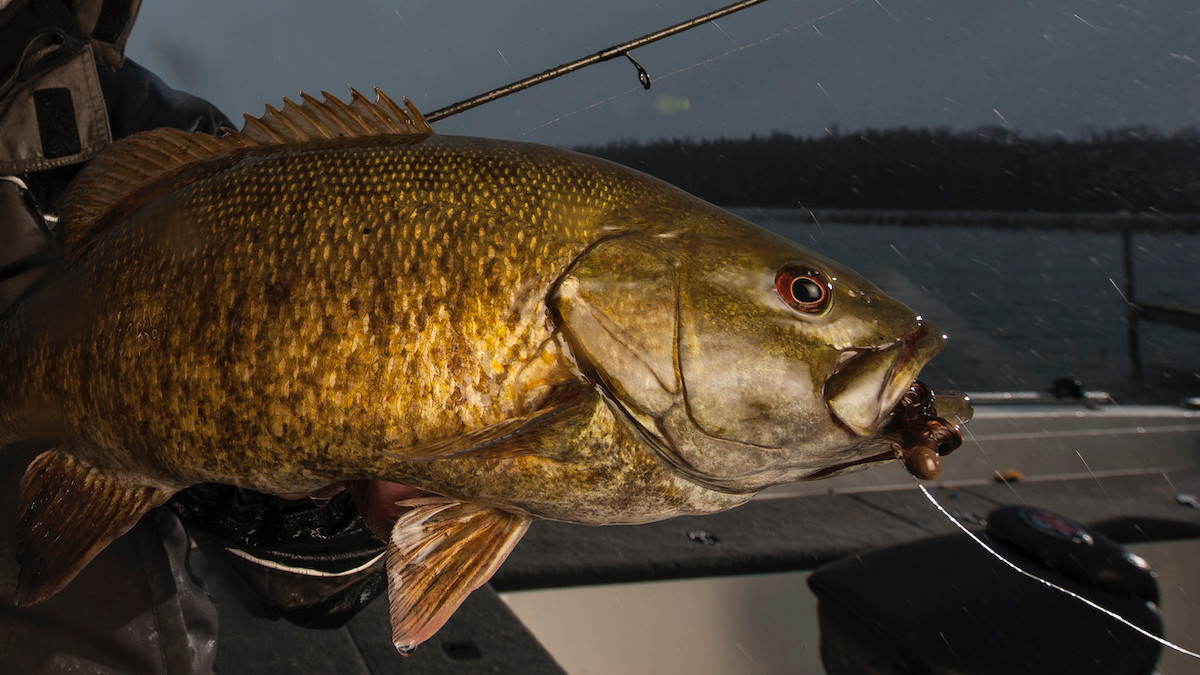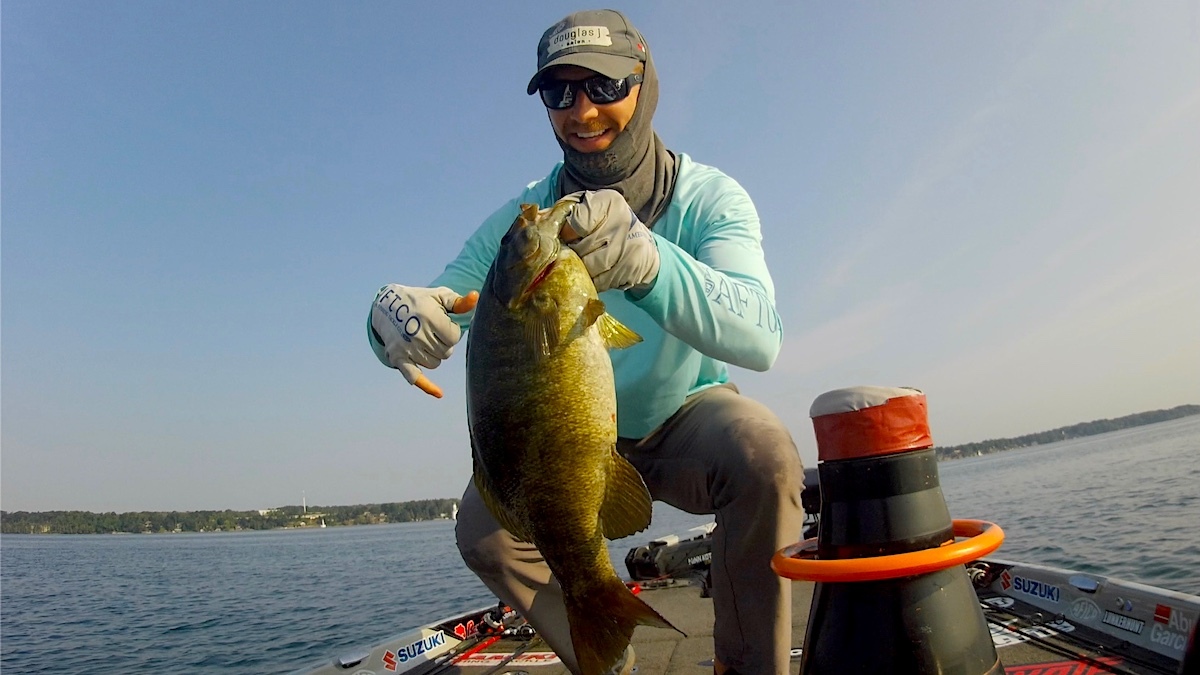
Michigan bass pro Chad Pipkens will turn 38 later this month, so he’s hardly old, but he’s already endured a lifetime of competitors’ complaints. Most recently, he’s grown sick of the hubbub over a glorified snorkel.
Well, not a snorkel exactly. In this case the subject of the dispute is a bathyscope, which to the untrained eye looks like a big orange traffic cone. If you drove around many clear, northern lakes the first half of this summer, or observed some of the Bassmaster Elite Series or Bass Pro Tour events, you likely saw some of the best bass anglers on Earth with these cones stuck into the water, peering through the smaller end, aimed toward the bottom. Pipkens didn’t win any of those derbies, but several of those who did owe him a debt of gratitude. After all, without his influence, it might never have gotten this far.

“We were fishing a BFL up in Northern Michigan and the fish were spawning,” he recalled. “It was calm the first day and we could see them, but it was breezy the next day and we couldn’t, so we went to Wal-Mart for snorkels. I ended up winning the tournament. Then we did some research and my buddies and I ended up ordering them from Italy, for maybe $120 each.”
That investment back in 2008 paid off big time, with numerous wins and top finishes for Pipkens and his cohorts. While fishing with his friend Ryan Said at the Thousand Islands on the New York-Canada border the next year, Said invoked the named of his favorite band, Flogging Molly, to describe their ongoing whackfest: “We’re putting the flog on ‘em,” he said. That led to them jokingly naming the product “The Flogger.” It was distinct and it stuck.
It didn’t remain a secret by any means. Television host Mark Zona featured it on his program a few years later, the Flogger was featured in magazines, and Pipkens arranged for one of his sponsors to import and widely distribute it. This past summer, though, was the tipping point when it went from a slightly-under-the-radar low-tech piece of gear to a flash point for various pundits’ and anglers’ views on morality and ethics. Once various competitors started winning with bathyscopes on a national stage, and making it appear that you could not effectively compete in certain circumstances without one, the predictions of “the end of fishing as we know it” started coming out of the woodwork in droves.
There’s nothing new about fears that a new piece of gear would make competition unequal between the haves and the have-nots—or worse. When recreational-oriented sonar first emerged, the chicken littles loudly proclaimed that fish populations would be wiped out. In fact, some manufacturers have used this alarmism to their apparent advantage—as evidenced by misleading advertisements for lures that are “banned from 20 states” or “prohibited in tournament use.” More recently, the disagreement has been over forward-looking sonar technology that enables anglers to identify and cast to individual fish and then tailor their presentation to the quarry’s reaction. Those units typically cost two- to four-thousand dollars apiece, and many top pros have two of them on the console of their bass and boats and two or three more on the deck. Even if you don’t think it provides a meaningful competitive advantage, at least you could make a colorable argument that the average working man is being priced out of the game. The Flogger, though, costs just over a hundred bucks.
“You could probably even make one for $7 to $10,” Pipkens said. That’s less than many crankbaits, and certainly most high-end swimbaits. If you can’t afford that, then you likely can’t afford gas to get to the lake. Furthermore, it’s likely less technologically-advanced and less expensive than the polarized sunglasses that most serious anglers rely upon, and no one is complaining about those (just give them a year—it could happen when they run out of other targets). Hell, the DIY Flogger may even cost less than that original Wal-Mart mask and snorkel.
Pipkens thinks there’s a simple explanation for the opposition: “The people who complain are too lazy to put in the work. Their argument is the biggest crock I’ve ever heard in my life.”
And therein lies the underlying truth: There is no magic bullet, no lure that fish can’t resist, no piece of sonar that makes catching fish foolproof. You still have to put in the work. Nearly everyone on the major bass tours likely has forward-facing sonar by now, but only one of them can win. The others don’t even get participation trophies.
“Nothing is changing with who is winning,” Pipkens stated. “We’re just setting the bar higher with the weights we catch. People see Jacob Wheeler and Justin Lucas winning with it, but Jacob Wheeler and Justin Lucas were already winning without it. It’s the same thing as forward-facing sonar. The people who complain about this are going to complain about anything. Come on, man. We get to do what we love for a living.”
Limits on Flogging Just because you shell out the bucks for a flogger—or make one yourself out of a bucket, traffic cone, flowerpot or other apparatus—won’t make the spawning bass start jumping in your boat. As Pipkens noted, you must be physically nimble to get it right. That means getting down on your knees or belly, putting your face to the contraption, and taking your lumps.
“I’ve had black eyes, bloody lips, and holes ripped in my jeans from doing it,” he said.
You also need either a friend or a second set of arms to flog and fish at the same time. Friends of mine who fish team tournaments use the two-man approach to get it done. One guy mans the bathyscope and tells the other which way to move the lure and when to set the hook on a finicky fish. That’s all well and good in that situation or if you’re fishing for fun, but in top-level tournaments the competitors have to do everything themselves. Even in non-team events it’s infeasible because who wants to lose valuable fishing time to help the other guy or gal in the boat beat them?
On top of that, it takes a very specific set of conditions to need it and to do it right: You need gin-clear water, the fish should be in areas too deep to see with the naked eye, and they need to be staying in place. The spawning window may be a few months or a few weeks in some areas, but outside that time frame you’re likely wasting time by not covering water. You may also have to adjust your tackle to get it done.
Making the Most of Your Bathyscope The standard bathyscope available from leading tackle retailers is typically orange, thus the traffic cone comparison (although you may be able to get one elsewhere, often cheaper or even less technologically advanced models. It may appear there’s nothing wrong with the color. After all, it makes the floater easier to find in big waves after you corral a mean-spirited, tournament-clinching smallmouth. The problem is that the factory coloration lets in too much light. Many flogging experts either paint the exterior a darker shade or wrap it with something to substantially reduce that light intrusion.
Pipkens said that just as the Flogger is not a panacea, it’s also not a substitute for finding key areas. He still uses top-flight electronics in tandem with the cone to maximize his chances. In fact, once he finds areas with big spawning concentrations, he’ll often set out a drift sock, put the flogger down and glide through key areas looking for the best quality fish. He’ll chuck another decidedly low-tech tool—the humble marker buoy—over beds that seem to hold the largest fish, and then go back and check them.
Conservation Concerns? While there have been plenty of naysayers arguing that the Flogger is unsportsmanlike, unethical, or unfair, even anglers who’ve taken issue with other technology see the argument as ridiculous. Veteran Missouri pro Randy Blaukat, who operates a popular and occasionally controversial YouTube channel, has come out strongly against the escalation of boat costs driven largely by the “need” for more and more technology, but even he said that the Flogger doesn’t raise his hackles.
“I don’t think it should be banned,” he said on a recent recording. “The reason I say that is because this is not some high-tech piece of equipment that gives one angler a huge advantage over another angler.”
He did, however, note that this small-scale debate may be a proxy for a larger issue: Whether there should be large-scale tournaments during the spawn, relocating numbers of fish away from their nests, leaving the eggs unguarded for salamanders, gobies, and sculpins to eat them. The tournament organizations and most tournament anglers would argue that today’s fisheries are healthier than ever, and enhanced fish care results in little delayed mortality.
Their detractors argue that’s not the case. There’s little likelihood that they’ll find a way to meet in the middle, but a ban on tournaments during the spring and early summer doesn’t mean a stop to all fishing except in those few states with a closed season. The bottom line is that if you’re fishing at that time, you’re likely fishing for bedding bass whether you’re looking at them with your eyes, through a cone, or fishing for them blind.
Final Thoughts For the guy whose efforts (with friends) were largely responsible for bringing the Flogger to the public, Pipkens still has a few regrets. No, not that he released this orange kraken to the world, but rather that his competition has taken his ball and run with it.
“I never really got a chance to use it except in some BFLs,” he said, referring to some lower-level weekend tournaments. “I’ve caught a few fish in some Bassmaster Opens on it, and at the Thousand Islands I caught a 5-07 smallmouth and a 5-06. It was just a matter of time until it all lined up in a big tournament.”
His other regret?
He didn’t make the most of it financially. “It would’ve cost about fifteen grand to do molds, and we would have made a pile of money,” he lamented. Instead, for a period of time, he got ten bucks for each one sold. Not a major windfall, but not the end of the world either. He’s not complaining, but he figures it’s only a matter of time until someone moves on to the next big controversy. He’ll keep his head down, either in a cone, looking at his sonar, or just keeping to himself.




Conversation